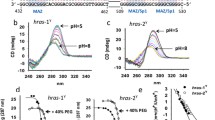Abstract
HumanAlu-elements are short interspersed DNA sequences that comprise approximately 5% of the human genome. The physiological role of Alu-elements are unknown, although they are proposed to be involved in DNA replication, transcriptional regulation and nuclear transport of signal recognition particle RNA. Proteins that bind to Alu-element and Alu RNA have been identified in human cells. In HeLa cells, two proteins of 120 kDa and 35 kDa specifically bind to Alu-elements. We find that the 35 kDa protein is localized exclusively to the nucleus, while the 120 kDa protein is distributed between nucleus and cytoplasm. The 35 kDa protein is regulated by phosphorylation. Upon dephosphorylation, its DNA-binding activity is significantly enhanced. Contrary to the recent identification of the smaller Alu-element binding protein as annexin 11, we find that annexin II is not an Alu-element binding protein. Using a variety of techniques, we demonstrate that the 35 kDa Alu-element binding protein is distinct from annexin II.
Similar content being viewed by others
References
Ullu E, Weiner AM: Human genes and pseudogenes for the 7SL RNA component of signal recognition particle. EMBO J 3: 3303–3310, 1984
Walter P, Blobel G: Signal recognition particle contains a 7S RNA essential for protein translocation across the endoplasmic reticulum. Nature (London) 299: 691–698, 1982
Weiner AM: An abundant cytoplasmic 7S RNA is complementary to the dominant interspersed middle repetitive DNA sequence family in the human genome. Cell 22: 209–218, 1980
Weiner AM, Deininger PL, Estratiadis AE: Nonviral retroposons: genes, psuedogenes and transposable elements generated by the reverse flow of genetic information. Annu Rev Biochem 55: 631–662, 1986
He XP, Bataille N, Friend HM: Nuclear export of signal recognition particle RNA is a facilitated process that involves the Alu sequence domain. J Cell Sci 107: 903–912, 1994
Schmid C, Maraia R: Transcriptional regulation and transpositional selection of active SINE sequences. Curr Opin in Genet Dev 2: 874–882, 1992
Ariga H: Replication of cloned DNA containing the alu family sequence during cell extract-promoting simian virus 40 DNA synthesis. Mol Cell Biol 4: 1476–1482, 1984
Saegusa, Y, Sato, M., Gali, I., Nakagawa, T., Ono, N., Iguchi-Ariga, S.M.M. and Ariga, H: Stimulation of SV40 DNA replication and transcription by Alu family sequence. Biochimica et Biophysica Acta 1172: 274–282, 1993
Perelygina L,Tomilin N and Podgornaya O: Alu-family repeat binding protein from HeLa cells which interacts with regulatory region of SV40 virus genome. Mol Biol Rep 12: 111–116, 1987
Tomilin N, Buzhkov V: Human nuclear protein interacting with a conservative sequence motif of Alu-family DNA repeats. FEBS Lett 251: 79–83, 1989
Boyko V, Svetlova M, Negishi Y, Ariga H, Tomilin N: A major cellular substrate for protein kinases, annexin II, is a DNA-binding protein. FEBS Lett 345: 139–142, 1994
Jindal HK, Chaney WG, Anderson CW Davis RG, Vishwanatha JK: The protein-tyrosine kinase substrate, calpactin I heavy chain (p36), is part of the primer recognition protein complex that interacts with DNA polymerase a. J Biol Chem 266: 5169–5176, 1991
Klee CB: Ca2+-dependent phospholipid-(andmembrane-)binding-proteins. Biochemistry 27: 6645–6653, 1988
Vishwanatha JK, Jindal HK, Davis RG: The role of primer recognition proteins in DNA replication: Association with nuclear matrix in HeLa cells. J Cell Sci 101: 25–34, 1992
Laemmli UK: Cleavage of structure proteins during the assembly of the head of bacteriophage T4. Nature 227: 680–685, 1970
Fanning E, Knippers R: Structure and function of simian virus 40 large tumor antigen. Annu Rev Biochem 61: 55–85, 1992
Mimori T, Hardin JA, Steitz JA: Characterization of the DNA-binding protein antigen Ku recognized by autoantibodies from patients with rheumatic disorders. J Biol Chem 261: 2274–2278, 1986
Glenney JR: Purification of calpactins I and II and isolation of N-terminal tail of calpactin I. Meth Ezymol 196: 65–69, 1991
Chang D.-Y, Nelson B, Bilyeu T, Hsu K, Darlington GJ, Maraia RJ: A human Alu RNA-binding protein whose expression is associated with accumulation of small cytoplasmic Alu RNA. Mol Cell Biol 14: 3949–3959, 1994
Yamazaki H, Nomoto S, Mishima Y, Kominami R: A 35-kDa protein binding to a cytosine-rich strand of hypervariable minisatellite DNA. J Biol Chem 267: 12311–12316, 1992
Author information
Authors and Affiliations
Rights and permissions
About this article
Cite this article
Chiang, Y., Vishwanatha, J.K. Characterization of the HeLa Cell 35 kDa Alu-element binding protein. Mol Cell Biochem 155, 131–138 (1996). https://doi.org/10.1007/BF00229310
Received:
Accepted:
Issue Date:
DOI: https://doi.org/10.1007/BF00229310




